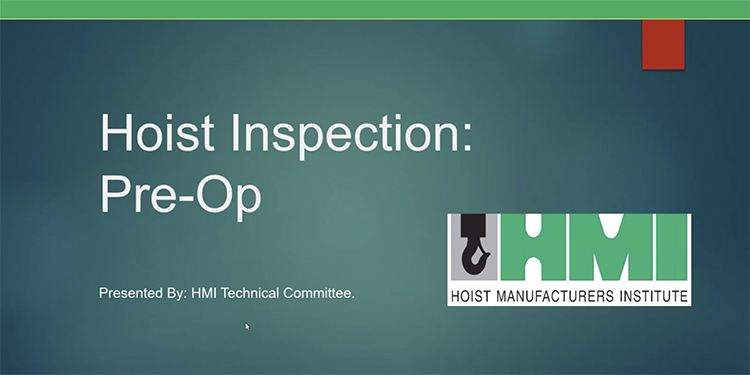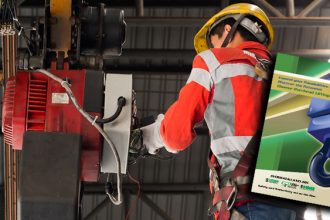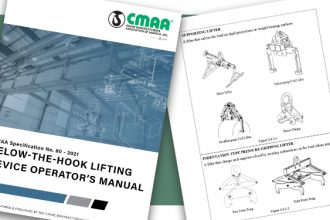Hoist Inspection Webinar, Part 1: Why Performing Daily Pre-Operational Assessments Is Important

Recently, the Hoist Manufacturers Institute (HMI) of MHI hosted a webinar entitled “Pre-op/Daily Hoist Inspection: What You Need To Know To Be Safe, Productive and Compliant.” The 45-minute session explained the importance of conducting an assessment of an overhead hoist — including wire rope, chain and lever types — at the beginning of each shift (or workday) prior to using the equipment for vertical lifting of freely suspended loads.
This, the first of a two-part post, reviews why such inspections are important, the requirements for such evaluations, available resources to guide the process, and recommendations for maintaining documentation of completed inspections. Additionally, the presentation offered a detailed walk-through of the key areas to inspect; those are discussed in the second part of this post.
Why are pre-operational/pre-shift hoist inspections important? There are three reasons.
- Safety. Because hoists serve as the principal device that both raises and lowers a load and connects it to an overhead crane for lateral movement, their reliable operation is critical to the safety of operators and workers in the facility. The loads they handle are heavy, and can be expensive, critical equipment. A hoist failure could not only endanger the lives and safety of those working in a facility, it could also cause extensive damage to the product and the operation.
- Compliance. Properly conducting hoist inspections enables an operation to adhere to a variety of safety standards. It is important to remain in compliance with the Occupational Safety and Health Administration’s OSHA-CFR 29 Part 1910.179, the federal regulation that applies to overhead and gantry cranes (to which hoists are typically attached), which requires inspections of new and altered cranes and hoists prior to use and at regular intervals by a trained, qualified professional. Further, two standards from the American Society of Mechanical Engineers (ASME) — ASME B30.16 Overhead Hoists (Underhung) and ASME B30.21 Lever Hoists — call for regular inspections performed by qualified persons trained to do so. HMI also specifies regular inspections of hoists to identify wear and damage that could adversely affect their safe use.
- Productivity. A hoist whose condition and operation are regularly verified and that is properly maintained eliminates the risk of unplanned downtime. Such inspections are a key contributor to ongoing hoist productivity during every shift.
What resources are available to guide hoist inspections? HMI offers several free publications detailing hoist inspection procedures, including the free, comprehensive guide, “Hoist Inspection and Maintenance Personnel Manual.” For daily pre-operational/pre-shift inspections, HMI has published three separate free checklists, one each for electric powered and air powered hoists, hand chain hoists, and lever hoists. HMI also recommends that all inspections adhere to the guidelines covered in the equipment owner’s manual provided by the hoist manufacturer. Best practice is to keep a copy of the hoist’s manual in close proximity to the equipment, as it contains guidance on usage capabilities and limitations, as well as troubleshooting information.
What qualifications must the person performing the pre-operational inspection meet? Neither the OSHA nor the ASME standards spell out specific requirements or qualifications for performing an inspection. However, best practice is that an internal maintenance expert or a trained operator familiar with the equipment, its components, its operation, and areas of inspection focus (operating mechanism, hoist limit devices, hooks, latches, and lifting media) — as covered in HMI’s daily operator inspection checklists — perform these evaluations. Someone familiar with the equipment should be able to complete the inspection in five minutes or less.
What should be done with the completed checklists? Completed checklists should be submitted to either the head of maintenance or the person who oversees equipment and kept on file within the facility. This documentation verifies that the inspections are being performed properly and on schedule, and that the equipment is operating both effectively and safely.
In addition to hoist inspection publications, HMI offers a variety of other technical resources — including a comprehensive library of product guides; a hoist certification program; OSHA Alliance safety tip sheets, fact sheets and quick cards; multiple technical papers and more — via its website at www.MHI.org/hmi.
More details about performing hoist inspections are included in this recent MHI Solutions magazine article. Click to download a free copy of HMI’s Daily Operator Checklists for Hoists (Powered, Hand Chain and Lever Operated).



